Outside of the Foot Pain [Lateral Foot Pain]
Fibularis (Peroneus) Longus Tendonitis: [Best Treatment For Tendon Pain!]
Fibularis (peroneus) longus tendon overuse and inflammation can lead to painful peroneus longus tendonitis: We show the 100% best treatment to FIX IT!
- It usually occurs due to chronic overuse or inversion ankle sprain!
Table of Contents
What are the Peroneal Tendons:
The Peroneus Longus & The Peroneus Brevis:
- There are two peroneal tendons on the outside of your foot and ankle.
- Both tendons begin in the upper outside leg.
- Both course down through the outside of your ankle.
- The Peroneus (Fibularis) Brevis inserts onto the outside of your foot.
- The Peroneus (Fibularis) Longus courses under your foot and the base of your 1st metatarsal.
- They are both. They are responsible for turning your ankle out.
- The Peroneus (Fibularis) Brevis turns your foot up and out.
- The Peroneus (Fibularis) Longus turns your foot down and out.
Peroneus Longus Tendon Anatomy:
The peroneus longus origin and insertion: The origin is the superior two-thirds of the lateral shaft of the fibula and fascia. The insertion of the peroneus longus muscle is the plantar aspect of the medial cuneiform and the plantar first metatarsal base.
- This picture diagrams the peroneus longest tendon anatomy.
- The peroneus longest tendon originates in the proximal 50% of the outside of the leg and inserts along the lateral aspect of the ankle and into the plantar foot.
- This is a very complex route, and it is detailed below.
- The peroneus longest tendon is subject to split tears and overuse injuries.
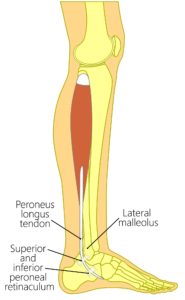
- The peroneus longest tendon inserts into the plantar aspect of the first metatarsal joint. This is shown in the picture below.
- The peroneus longest tendon is a much more complex route to its insertion than the peroneus brevis tendon, which has its insertion into the styloid process of the fifth metatarsal.
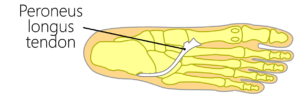
Peroneus longus innervation:
- The peroneus longus innervation is supplied by the superficial fibular (peroneal) nerve.
Peroneus longus function & action:
Plantarflexion of the 1st metatarsal, eversion of the foot, and support of the arches.
The Peroneus Longus Muscle Tendon:
The peroneus longus muscle runs from your high outside leg to the outside of your foot and inserts underneath your foot to the first metatarsal base.
- Its motion includes plantarflexion & eversion of the foot.
- It can dislocate, causing a clicking noise.
- It can also be inflamed from chronic overuse.
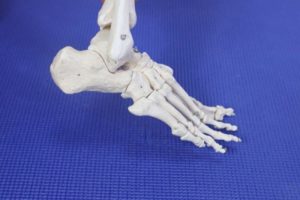
Fibularis (Peroneus)Longus Tendonitis Causes:
Tendinitis means there is inflammation of the tendon:
- This means there is burning, swelling, and redness of the tendon.
- Peroneus longus tendinitis occurs from the overuse of the motions of turning your foot out while pushing off simultaneously.
- This is a motion that is not all that popular. Thus, this muscle is not all that well known.
- But this muscle is constantly working hard to maintain your foot balance.
- Any sport or action that requires maintaining your balance is definitely utilizing the peroneus longus tendon.
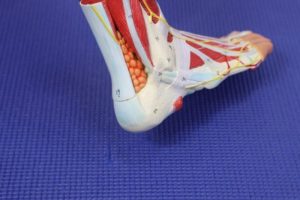
Most common activities:
- Any sport requiring balance and pushing off.
- Working a long shift.
- Standing for prolonged periods of time.
- Much more susceptible to this if you have previously rolled your ankle.
Fibularis (Peroneus) Longus Tendonitis Symptoms:
- This is an overuse injury.
- Swelling on the outside of your leg.
- Swelling on the outside of your ankle.
- Pain that gets better as you start moving.
- Pain is worse in the morning.
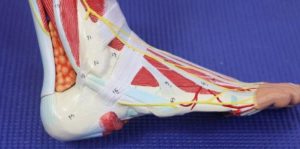
Fibularis (Peroneus) Longus Tendonitis Treatment:
1)Rest.
- No athlete wants to hear it.
- Any high-impact activity will prolong the healing time. Try to find an activity that puts less strain on the peroneus longus tendon.
- These include swimming or biking for at least a week or two.
- At least until the inflammation calms down.
2) Cryotherapy:
- This is most beneficial after activity & soreness.
- Icing 2-3x per day for about 15-20 minutes will decrease the flow of inflammatory cells into the muscle.
- Afterward, the arteries will vasodilate, further flushing out inflammatory cells from the region.
- Ice has deeper penetrating power than heat.
- Do not use heat after activity or further irritation of the region.






3)Elevation:
- If possible, elevate your leg while watching TV.
- This prevents stasis of the venous backflow within the leg.
- This is not as essential as cryotherapy, but if possible, it will help!
4)Compression:
- This is similar to the elevation treatment.
- Compression socks & stockings are available that could really help you out!
- It will increase the backflow of venous blood and help flush out inflammatory cells.
- Use an ACE bandage or any other type of compression wrap.
- It should not be so tight that it cuts off blood flow!




5)Topical anti-inflammatories or analgesics:
- There are anti-inflammatory creams that can be prescribed by your podiatrist that can decrease the inflammation and speed up your healing time.
- Over-the-counter include Capsaicin.
- Voltaren or any diclofenac gel works great.
- Biofreeze or anything with menthol in it.








6)Oral NSAIDs:
- These include Ibuprofen & aspirin.
- This can be over the counter or prescription.
- Do not take these unless instructed to do so by your physician or podiatrist.
- Take a 1-2 week course to decrease inflammation and speed up your healing time.
- Take 2-3x doses per day as instructed. This builds up anti-inflammatory enzyme levels in your system.
- Taking just 1-2 pills and then stopping does nothing for inflammation!
7)Get Good Shoes:
- Use a Brannock device to fit your shoes properly.
- Make sure your toe and pinky toes fit properly.
- Make sure it is a rigid soled shoe (that does not twist very easily).
- Fit your shoes at night when they are the most swollen.

8) OTC Orthotics:
- Some biomechanical abnormality is causing this strain in the first place.
- If your foot is off balance, there is abnormal tension in your peroneus longus muscle.
- An orthotic can counteract this abnormal biomechanical positioning.
- This will prevent excess strain on your peroneus longus tendon.
















9)Physical Therapy:
- There is a great deal of scientific evidence showing that this will greatly improve healing time.
10) Podiatrist:
A podiatrist can assess your biomechanical abnormalities & get to the root of the problem!
Muscle & Tendon Pain:
- Peroneus Brevis Muscle Tendon Pain.
- Peroneus Longus Muscle Tendon Pain.
- Peroneus Tertius Muscle Tendon.
